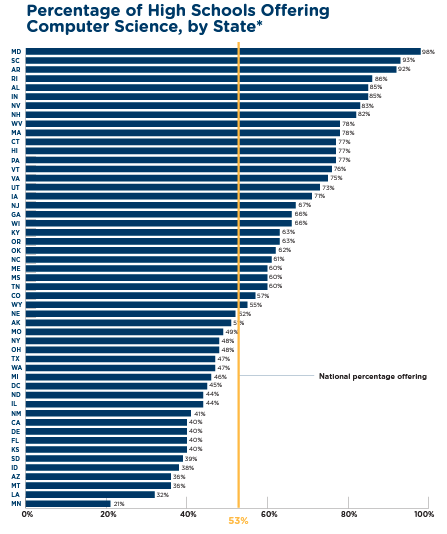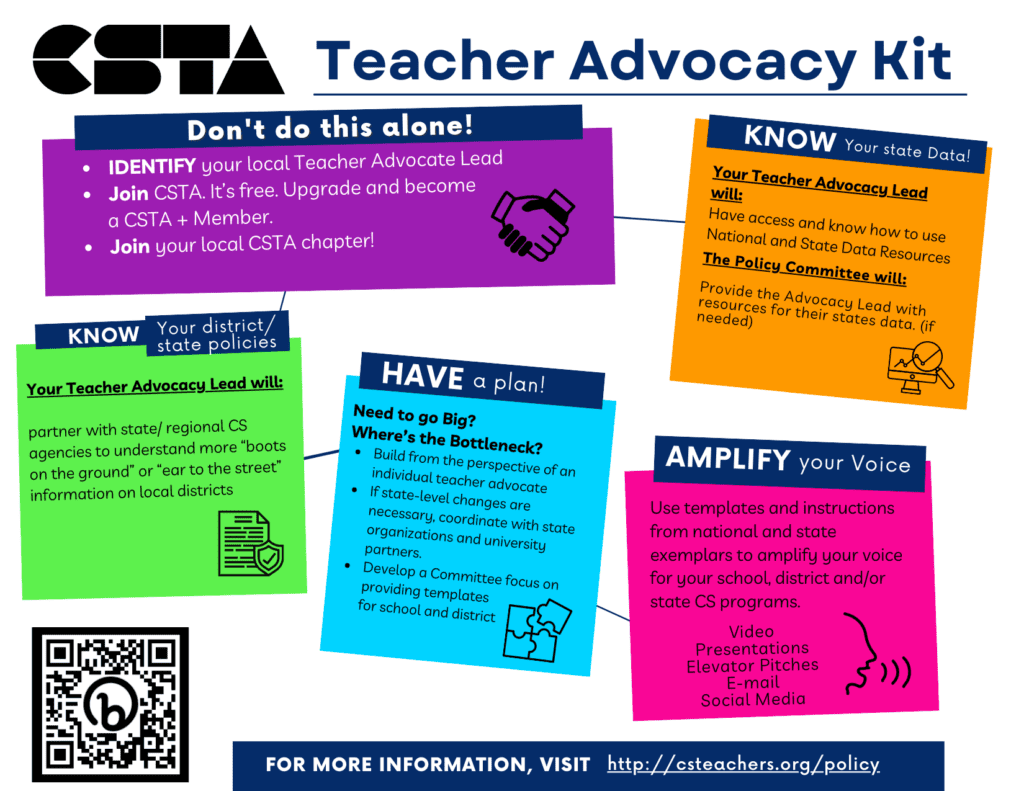Posted by Alexandra Holter on Apr 26, 2023

A lack of policy on computer science education underscores the importance of recognizing computer science as a core subject that is as essential as math, literacy, social studies, and science.
Full Story
Promoting increased awareness of the urgent need to provide all students equitable access to high quality Computer Science instruction is complex. However, the effort is worth the reward if all students can be offered the opportunity to possess the empowerment and confidence that comes with obtaining a computing identity.
One tactic used by many states is to pursue state-level policies that require CS for all students. The states that have passed state legislation supporting computer science policy are, not surprisingly, offering more CS in schools, and also show greater gains in their ability to prepare students for a technology driven future through computer science education. In total only 27 states require schools to teach computer science.
Let’s consider why this number needs to be increased and what educators can do to make change in their state.

I speak to you from my state’s perspective (Minnesota- last in the nation) in hopes that others will find themselves reflected in some of our struggles and be called to action.
Minnesota is currently ranked last in the nation when it comes to the percentage of schools that offer computer science. This may be a direct result of Minnesota’s lack of policy related to computer science education. Without clear policies, there are disparities in access to computer science education across schools, districts, and communities. This results in unequal opportunities for students to develop the skills needed for the digital age, exacerbating the digital divide and hindering the state’s ability to compete in a technology-driven economy.
Minnesota’s lack of policy on computer science education also underscores the importance of recognizing computer science as a core subject that is as essential as math, literacy, social studies, and science. Without explicit policies, computer science is frequently viewed as an optional or supplementary subject, rather than an essential part of a well-rounded education. The unintended consequence of not viewing CS as a foundational subject is limiting the availability of computer science courses in K-12, teacher training, and resources, resulting in a missed opportunity to prepare students for the rapidly changing job market and society.
The lack of computer science education policies is not limited to Minnesota. Several states lack comprehensive policies that prioritize computer science education which results in:
- Inequity and Underrepresentation: The lack of policies to promote computer science education contributes to the existing disparities and underrepresentation of minoritized populations and women in the field.
- Lack of consistent standards, guidelines, and funding mechanisms: This leads to fragmented and inconsistent implementation of computer science education initiatives.
- Negative Economic Impact: Computer science is a driving force behind technological advancements and economic growth. “The U.S. currently produces too few specialists to meet future employment demands.” States failing to prepare students with foundation CS skills will be at a further economic disadvantage within a competitive global marketplace.

Getting started or involved in state policy can feel daunting. The Computer Science Teachers Association (CSTA) Teacher Advocacy Kit can be a powerful tool to address the lack of computer science education policies by providing resources for educating policymakers, engaging with stakeholders, sharing success stories, providing resources for policy development, and advocating for equitable policies. By leveraging the CSTA Teacher Advocacy Kit, teachers and advocates can effectively advocate for policies that prioritize computer science education and help close the gap in computer science education policy at state and local levels.
Action steps and ways to get involved:
- Join the CSTA Policy Committee
- Connect with you local CSTA chapter to partner on state initiatives
- Check out the Teacher Advocacy Kit
- Continue to bring awareness to CS education by sharing your stories on social media.
- Reach out to your local state representatives and start a CS education conversation.
- Understand your states 2022 State of Computer Science Education
About the Author

Alexandra Holter is a Computer Science Coordinator, K-12, for Bloomington Public Schools in Bloomington Minnesota. She has been an educator for the past 14 years. Her career started in Tulsa Oklahoma where she obtained her BA and Masters of Science in Mathematics and Science Education. Then she first taught her first class of 7th grade science and has been committed to eliminating young people’s barriers to STEM ever since. In 2015 she completed her Ph.D.in Educational Leadership and Policy Studies from Oklahoma State University. In her current role she supports K-12 teachers and schools with building their individual and site level CS capacity so that CS really can be for all. She is a current member of the CSTA Policy Committee and serves on the CSTA Editorial Board.



